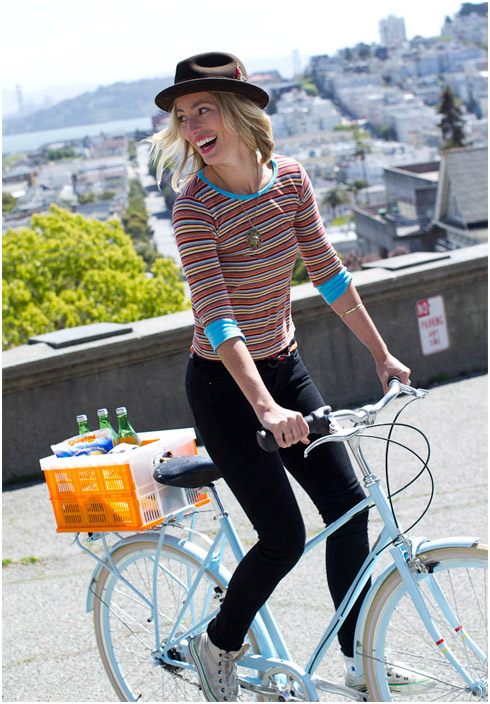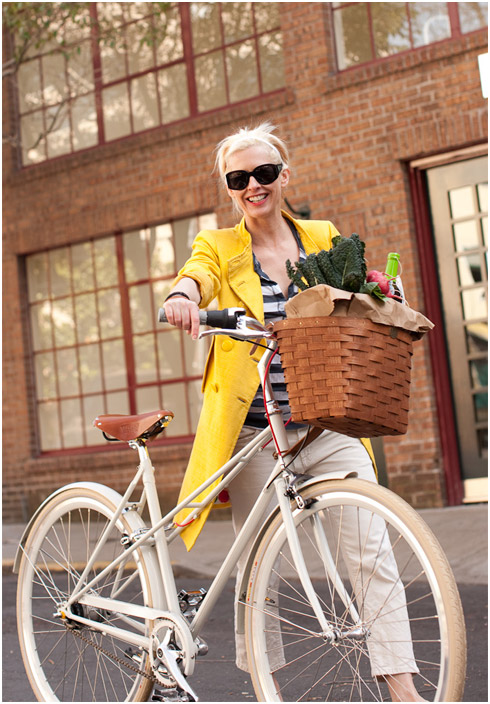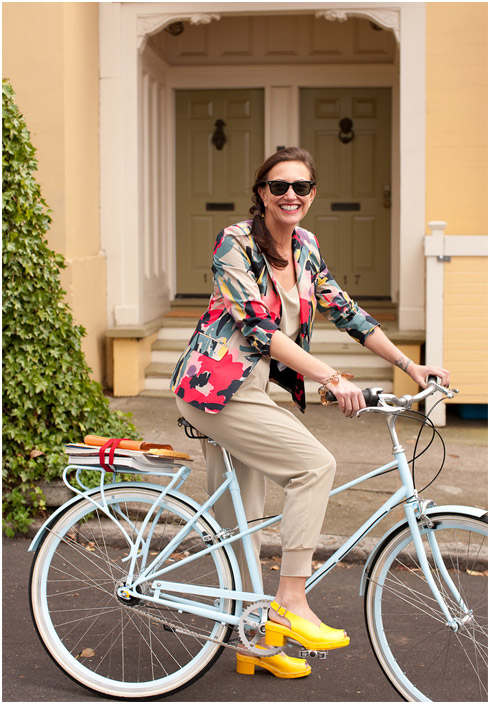The first thing that pops into my mind when I think of cycling in style is the Netherlands. For the Dutch, getting from point A to B on a bicycle is a way of life. Sometimes even with kids and pets in tow. The flat country is ideal for bike commuting and there are proper designated bike paths almost everywhere, right alongside regular car traffic. Rain or shine, people climb onto their bikes to commute to school and work, run errands, shop, visit friends, go out for supper, or drop off the children at kindergarden. Environmentally friendly, empowering and a great way to get those endorphins flowing. I love it!
The best part? Bicycle commuters in the Netherlands epitomize wear regular clothes and look every bit as stylish on their bikes as they do walking down the street.
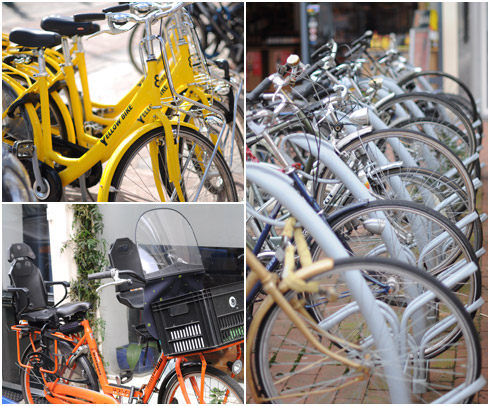
Although bike commuting isn’t as popular here in the US, it is getting more popular in urban areas and over the last few years several of my Seattle clients have needed to make their wardrobe compatible with their need to cycle to work. It was fun thinking through their requirements and I thought I would try to summarize what we learned. I also recently asked our stylish forum members across the globe what they wear when they commute on their bikes.
I should make it clear that I’m going to focus on regular clothes. Cycling gear is very snazzy these days, but if you dress like Lance Armstrong on the Tour de France when you bike to work, then that’s a topic for a different post.
With a little forethought you can absolutely look urban and stylish while commuting on a bicycle. As Liz Patek (@bikepeacenyc), a stylish proponent of cycling in New York City, puts it, “For me, the cycle chic movement isn’t about fashion per se, but about people on bikes dressed as they would normally dress for the destination. It’s the idea of normalizing people on bikes.”
Start at the Bottom
The first thing to get right is the bottom part of your outfit. Slim leg trousers and jeans are ideal, as are shorts and cropped styles that narrow at the hem. Bottoms with flared legs will work if you hold down the hems with trouser straps, clips, velcro fasteners or rubber bands. Flared skirts and dresses are great as they allow for ample pedal movement.
Pencil skirts are harder. Liz says they are the one exception to her “if you can walk in it you can bike in it” rule. Some women on our forum thread felt that they weren’t impossible if you hitched them up a little and chose a style in a stretchy fabrication.
Some ladies like to wear cycle shorts under their skirts and dresses in case the wind blows them up. Wearing leggings under skirts and dresses is another way to stay modest and keep warm. Generally, skirts that are too short or long are problematic. The former are immodest and the latter get caught in your bike chain.
The Top
The top part of the outfit is pretty much up to you and depends on the weather. Some ladies prefer to wear loose top layers for extra comfort. Others prefer to wear form fitting items that won’t flap around in the wind. Shorter coats and jackets are easy because they won’t get caught in your bike spokes, but longer coats are also fine if your bike has a coat guard. These days you can get extremely stylish wind and weather proof trench coats, coats and parkas, which keep you looking swish and feeling protected on your bike. As the weather chills, it’s essential to wrap up with wind proof gloves and an insulating scarf.
The Feet
Wearing regular footwear on a bike is quite doable with pedal cages. Some ladies prefer to wear flat footwear, but low heels and wedges are fine. Some ladies successfully bike through the city in high heels! As temperatures drop, you need to keep your feet warm with breathable socks or tights, and closed footwear or boots. Tucking skinnies into boots is an ideal urban cycling look.
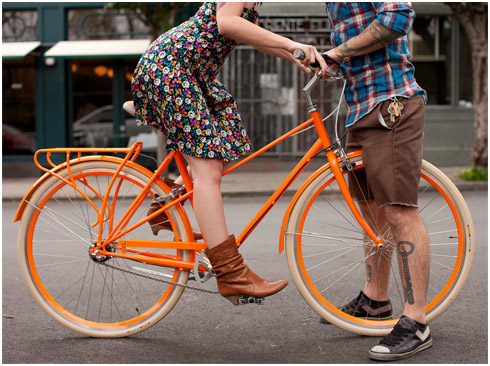
Bags and Baggage
Handbag preferences will vary. Some like to wear a small crossbody bag, while others prefer to carry a larger bag that they place into the front basket of their bikes. Others need to carry a laptop, which means carrying it in a waterproof sleeve, back pack, or messenger bag like this example by Timbuk2.
Fitting your bike with storage bags like panniers is a super idea. It allows you to carry heavy things like groceries, packages and books, or your handbag and laptop.
Changing it Up
If the items you want to wear are not bike-friendly, change into them once you’re at your destination. For example, if you can’t bike in a pencil skirt, wear trousers and swap it out for the skirt upon arrival. Feel like wearing white jeans? Wear blue jeans on your bike, but swap them for white jeans at work. Don’t want to crease and stain a silky blouse? Bike in a casual knit top and change your top for a blouse in two ticks. Wear flats if that’s your biking preference, and pack the heels.
I’ve also suggested to my clients that they keep an assortment of blazers and footwear at work so they don’t need to carry wardrobe items daily. Some keep a small steamer in their office if their clothing gets too creased. A toiletry bag complete with lint brush, hairbrush and dry shampoo is handy should you feel the need to freshen up after your ride.
If you bike in extreme weather, you might need extra stuff to pop on over your outfit like rain pants, raincoat, rain boots or snow boots. In Europe, you’ll often see people wear a rain cape over their regular clothes. It drapes over the handlebars and pretty much keeps your outfit dry if you also wear weatherproof footwear. And these days stylish weatherproof footwear is commonplace, especially if you use waterproofing spray.
Be Safe
Biking in the dark requires a bit of luminous outfit action, either in the form of a day-glo jacket or reflective band. These can be packed away until you need to use them. Who says neon can’t be fashionable!
Wearing a helmet while you cycle is a discussion point in itself. Generally, people in Europe tend to leave them off, while people in America prefer to wear them. This is partly to do with the environment. It’s safer to bike in many parts of Europe (the Netherlands especially) because roads and traffic are geared up for bike commuters. In America drivers are not trained to look out for cyclists and we don’t have designated bike paths, which makes things a lot trickier. Helmet head can be a problem, but safety should be your primary concern.
Thanks again to our forum members and Liz Patek for their inputs. And to PUBLIC bikes for sponsoring the post and providing us with most of the beautiful pictures (all but the very first one, which is from our last visit to Amsterdam). Check out blogs like Copenhagen Cycle Chic, Velocouture and Amsterdamize for great visuals showing how people of all ages commute on bikes in stylish, regular clothes.
We’d love to hear about your cycling experiences and your suggestions about cycling in style — please share them with us in the comments section below.
Competition
Today we are launching a competition where one lucky YLF member will win a PUBLIC bike. It involves posting a picture of your own cycling outfit and is sure to be a lot of fun. Check the competitions section for details.
You can like PUBLIC on Facebook and follow them on Twitter.
